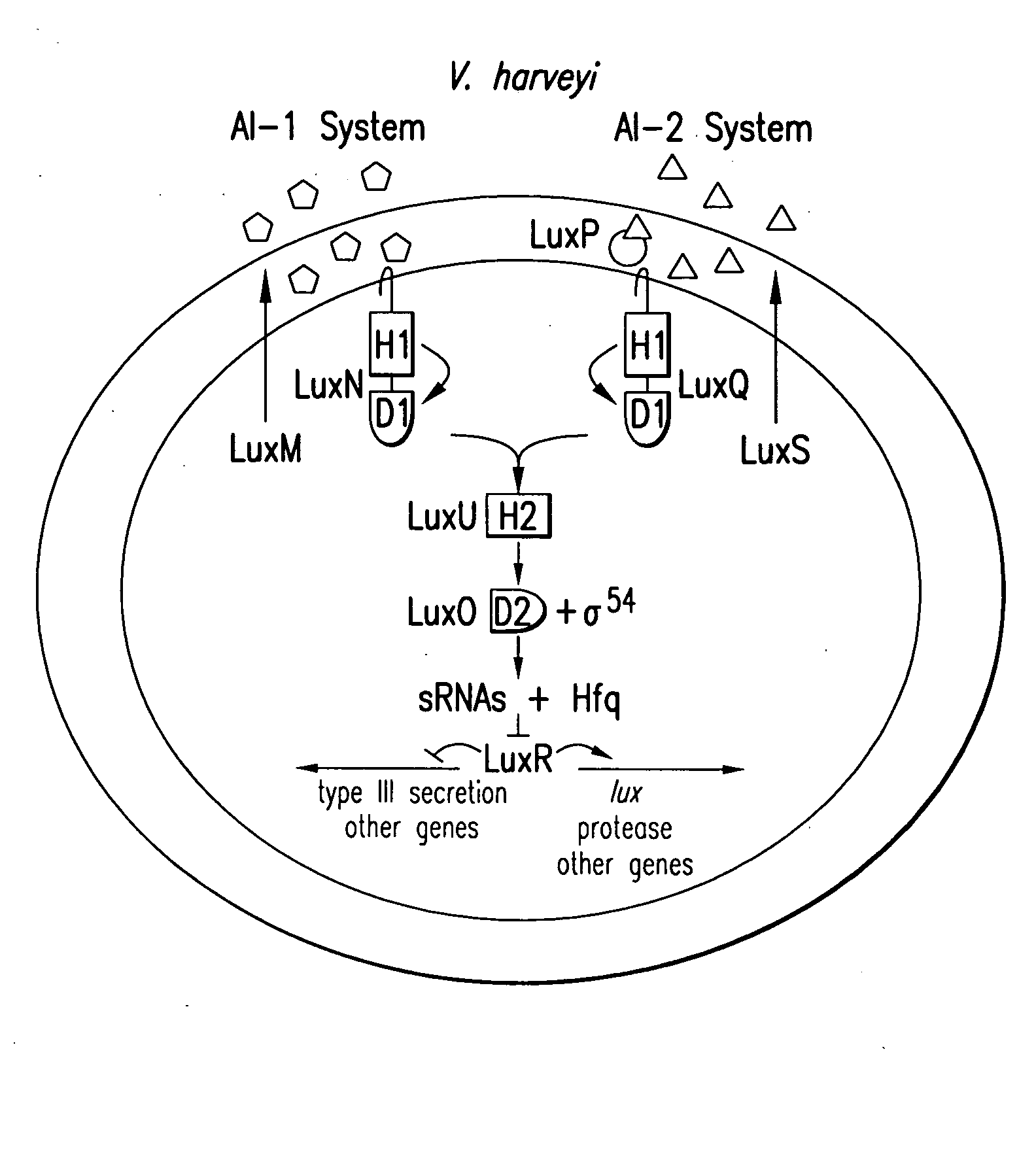Small RNAs and bacterial strains involved in quorum sensing
a technology of quorum sensing and small rnas, which is applied in the field of small rnas and bacterial strains involved in quorum sensing, can solve problems such as ineffective behavior
- Summary
- Abstract
- Description
- Claims
- Application Information
AI Technical Summary
Benefits of technology
Problems solved by technology
Method used
Image
Examples
example 1
Experimental Procedures
A. Bacterial Strains and Media
[0065]V. harveyi strains are derived from BB 120 (Bassler et al., 1997) and were grown at 30° C. with aeration in Luria-marine (LM), heart infusion (HI), or autoinducer bioassay (AB) broth (Bassler et al., 1994b; Freeman et al., 1999). V. cholerae strains are derivatives of El Tor strain C6706str2 (Thelin et al., 1996) and were grown at 30° C. with aeration in Luria-Bertani (LB) or SOC broth (Sambrook et al., 1989). For studies of toxin coregulated pilus (TCP), V. cholerae was grown at 37° C. in AKI medium under AKI conditions (Iwanaga et al., 1986). E. coli S17-1λpir (de Lorenzo et al., 1994) and JM109 (Yanisch-Perron et al., 1985) were used to propagate plasmids at 37° C. in LB. The following antibiotics were used: ampicillin (amp), 100 μg / ml; tetracycline (tet), 10 μg / ml; kanamycin (kan), 100 μg / ml; chloramphenicol (cm), 10 μg / ml; and gentamicin (gent), 100 μg / ml. Streptomycin (strep) was used at 1 mg / ml and polymyxcin B (pb...
example 2
A Genetic Screen for the V. harveyi Quorum-Sensing Repressor
[0072] A previously characterized LuxO allele, luxO D47E, was used to identify the repressor that acts downstream of LuxO (Freeman et al., 1999). The D47E mutation alters the site of phosphorylation, and “locks” the LuxO D47E protein into a state mimicking LuxO-P. The V. harveyi luxO D47E strain was mutagenized with the transposon Mini-MulacZ and screened for colonies that had acquired a bright phenotype, indicating that they had obtained a mutation bypassing the dark LuxO D47E phenotype.
[0073] Of the 40,000 transposon insertion mutants generated, 85 were bright. The majority of these (82) contained transposon insertions in either luxO or rpoN, the gene encoding σ54. Three bright mutants did not harbor mutations in either of these genes. A V. harveyi genomic cosmid library was introduced into one of these mutants (BNL211) and screened for restoration of the dark phenotype. All cosmids conferring a dark phenotype contained...
example 3
Hfq Regulates Quorum Sensing
[0074] To verify that Hfq has a role in quorum-sensing regulation in V. harveyi, hfq null mutations were introduced onto the chromosomes of the V. harveyi, hfq wild-type and luxo D47E strains. The Lux phenotypes of the single hfq and double luxO D47E, hfq mutants were examined and compared to those of the wild-type, luxO, and luxO D47E V. harveyi strains (FIG. 2B). Wild-type V. harveyi displays typical quorum-sensing behavior (squares): it is very bright immediately following dilution into fresh medium, but, early in the assay, luminescence decreases precipitously (˜1000-fold) due to dilution of the autoinducers to a level below that required for activation of lux. However, as the cells grow, endogenously produced autoinducers accumulate to the level required for detection. Light production commences and increases 1000-fold, ultimately reaching the predilution level. The luxO null strain (diamonds) is constitutively bright because, in the absence of LuxO...
PUM
| Property | Measurement | Unit |
|---|---|---|
| nucleic acid | aaaaa | aaaaa |
| cell density | aaaaa | aaaaa |
| fluorescent | aaaaa | aaaaa |
Abstract
Description
Claims
Application Information
 Login to View More
Login to View More - R&D
- Intellectual Property
- Life Sciences
- Materials
- Tech Scout
- Unparalleled Data Quality
- Higher Quality Content
- 60% Fewer Hallucinations
Browse by: Latest US Patents, China's latest patents, Technical Efficacy Thesaurus, Application Domain, Technology Topic, Popular Technical Reports.
© 2025 PatSnap. All rights reserved.Legal|Privacy policy|Modern Slavery Act Transparency Statement|Sitemap|About US| Contact US: help@patsnap.com



